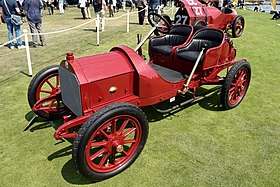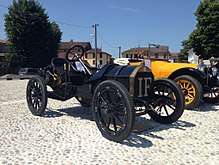Isotta Fraschini Tipo FE & FENC
| Isotta Fraschini Tipo FE & FENC | |
|---|---|
 1909 Isotta Fraschini FENC | |
| Overview | |
| Manufacturer | Isotta Fraschini |
| Production | 3 (FE); <100 (FENC) |
| Model years | 1908 (FE); 1909 (FENC) |
| Assembly | Milan, Italy |
| Designer | Giuseppe Stefanini |
| Body and chassis | |
| Class | Voiturette |
| Body style | 2-seat, racing and touring |
| Powertrain | |
| Engine |
1.2 L SOHC inline-4 (FE) 1.32 L SOHC inline-4 (FENC) |
| Transmission | 3-speed (FE); 4-speed (FENC) |
| Dimensions | |
| Wheelbase | 2100 mm, 82.7" |
| Width | track = 1250 mm, 49.2" |
| Curb weight | 612 kg, 1350 lbs (FE); 657 kg, 1450 lbs (FENC). |
| Chronology | |
| Predecessor | Isotta Fraschini Tipo D |
The Isotta Fraschini Tipo FE was an early Italian race car, and the Isotta Fraschini Tipo FENC is the road version and is considered one of the earliest examples of a sports car.
History
Long thought to have been designed by Ettore Bugatti, the racing FE and road going FENC voiturettes were designed by pioneering Italian engineer Giuseppe Stefanini, with collaboration from chief design engineer Giustino Cattaneo.[1][2] Drawing from his first race car design, the monstrous 17.2 L SOHC inline-4 in the Isotta Fraschini Tipo D, which lasted but one lap in the 1905 Gran Premio di Brescia, Stefanini applied similar principles on a diminutive scale. In early 1908 he created the Tipo FE for entry in the Grand Prix des Voiturettes at Dieppe.
Tipo FE
The FE, with its innovative 3000 rpm, 18 hp, 1.2 L SOHC inline-4 of 62 x 100 mm,[3][4][5] was designed to the minimum 600 kg (1323 lbs) weight limit,[6] and had a top speed of 95 km/h @ 2500 rpm.[7] It sounded the death knell for the locomotive-like single- and twin-cylinder race cars of the day. The FE's design became the Continental standard and the archetype for the small high performance sports car.
1908 Grand Prix des Voiturettes
1908 GP des Voiturettes race results Photos of 1908 GP des Voiturettes

Tipo FENC
Consistent with Isotta Fraschini's policy of deriving road cars from its race cars,[8] the FE experience quickly led to a road-going FENC design in the latter half of 1908. A larger engine capacity of 1.32 L (65 x 100 mm) rated at 14 hp @ 2500 rpm, with a cross-drive water pump and magneto, and a 4-speed transmission were the major changes. Four versions were offered in 1909: bare chassis, Tipo A (Dieppe racing type, no fenders, running boards, or lights), 6750 Lire (fenders, running boards, lights an additional 250 Lire) - this version $2700 US; Tipo B (touring type, cloth roof, fenders and lights), 6950 Lire; Tipo C (touring type, leather and cloth roof, fenders and lights), 7870 Lire.[9][10] Top speed at 2500 rpm was 75 km/h with European wheels (710 mm) and 84 km/h with export wheels (810 mm). Due to severe economic conditions in 1909 and 1910, and a fading of buyers' interest in voiturettes, the FENC was produced for just one year. Today only five Tipo FENCs are known to exist of less than 100 built.[11]
References
- ↑ Anselmi, A.T. (1977). Isotta Fraschini. Osceola: Motorbooks International
- ↑ Borgeson, G. (1981), Bugatti by Borgeson. London: Osprey Publishing Limited
- ↑ Technical schedule for FE - G.P. des Voiturettes (Dieppe) 1908
- ↑ Anselmi, A.T. (1977). Isotta Fraschini. Osceola: Motorbooks International
- ↑ Borgeson, G. (1981), Bugatti by Borgeson. London: Osprey Publishing Limited
- ↑ Automotive Industries, Vol 18, #5. (1908) Monsters and Baby Racers Both Have a Grand Prix. New York City: The Class Journal Company
- ↑ Technical schedule for FE - G.P. des Voiturettes (Dieppe) 1908
- ↑ Anselmi, A.T. (1977). Isotta Fraschini. Osceola: Motorbooks International
- ↑ Isotta Fraschini. (1909). 1909 Isotta Fraschini catalog. Milano: Isotta Fraschini
- ↑ Isotta Import Co. (1910). Characteristics of the Isotta Fraschini Voiturette. New York: Isotta Fraschini
- ↑ Moore, S. (2012). FE and FENC: the Isotta Fraschini voiturettes. The Automobile, 30th Anniversary Edition, 64-73